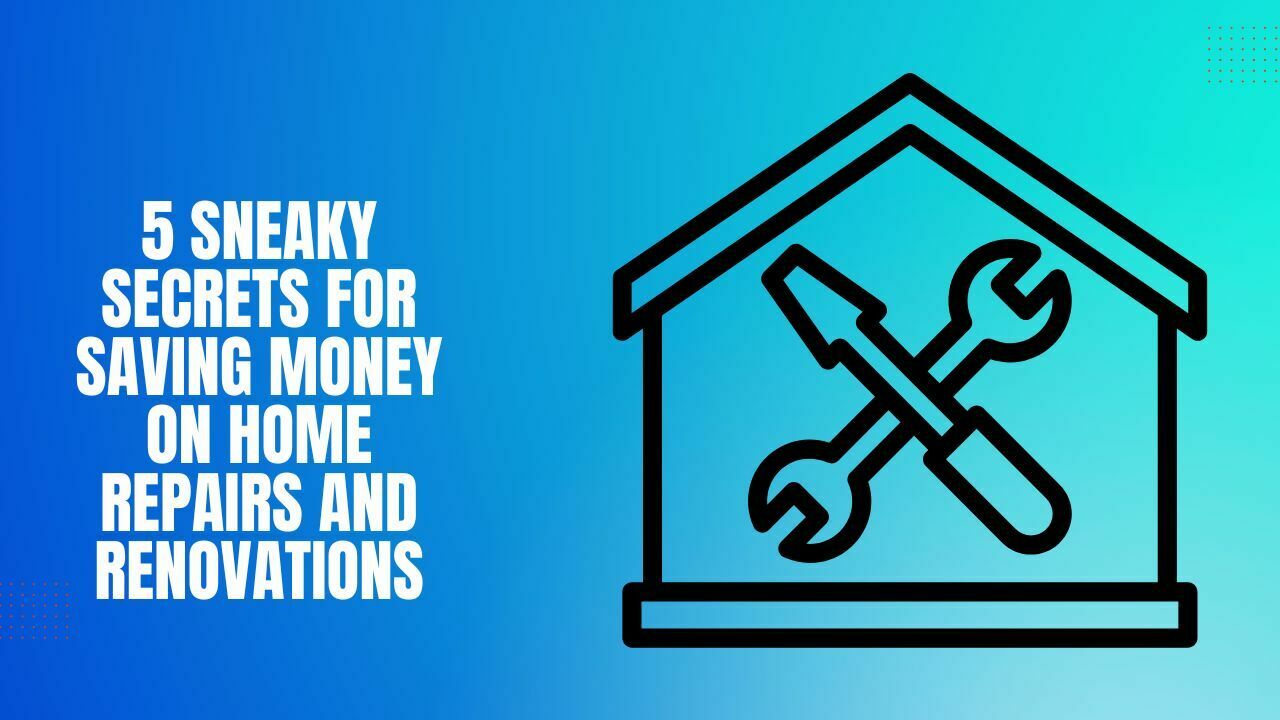Today, I want to let you in on a little secret that can help you save some serious cash when it comes to home repairs and renovations.
As someone who’s passionate about personal finance and finding clever ways to stretch every dollar, I couldn’t resist sharing these sneaky tricks with you.
After all, who doesn’t want to save money while creating the home of their dreams?
Now, before we dive into the nitty-gritty, let me throw some eye-opening statistics your way.
According to research by Pew Research, millennials are faced with unique financial challenges compared to previous generations.
We’re burdened with student loan debt, soaring housing costs, and a competitive job market.
It’s no wonder that finding ways to save money on home repairs and renovations is a top priority for many of us.
But fear not, because there is hope! Studies show that millennials are more likely to tackle home improvement projects themselves and seek out budget-friendly options.
In fact, according to Farnsworth Group, a whopping 73% of millennials prefer the do-it-yourself (DIY) route for home repairs.
By taking matters into our own hands, we not only save on labor costs but also gain valuable skills and knowledge along the way.
Now, here’s the exciting part. I’ve done my fair share of research, and I’ve uncovered some ingenious strategies that can help us save even more on home repairs and renovations.
We’re talking about sneaky secrets that will make you feel like a financial wizard.
You’ll discover how to source materials and supplies at discounted prices, negotiate better deals, and even barter and trade for what you need.
We’ll explore creative financing solutions, maximize tax benefits, and tap into the resources of friends and family.
These are the tricks of the trade that will empower us to take control of our home projects without breaking the bank.
Let’s get started!
1. The Millennial Mindset towards Home Repairs and Renovations

1.1 Financial Challenges and Priorities
From student loan debt to skyrocketing housing costs, we’ve got our plates full.
Here are some eye-opening statistics:
- The average student loan debt for millennials in the United States is a staggering $33,000.
- Millennials are spending a significant portion of their income on rent, with an average of 45% of their income going toward housing costs.
- Compared to previous generations, millennials are facing lower homeownership rates due to financial constraints and tighter lending standards.
With these challenges in mind, it’s no surprise that we’re all about finding ways to save money wherever we can.
We prioritize financial stability and making the most of our hard-earned dollars.
1.2 Significance of Home Repairs and Renovations in Millennials’ Lives
Homeownership holds a special place in the hearts of many of us.
It’s not just about having a place to call our own; it’s an opportunity for self-expression, creating a sanctuary, and building wealth for the future.
Here’s a look at some relevant statistics:
- According to a survey, 86% of millennials view homeownership as a vital component of the American Dream.
- Home renovations are on the rise among millennials, with 90% of them planning to renovate their homes within the next decade.
- The majority of millennials believe that home improvements increase the value of their property and offer long-term financial benefits.
In short, we millennials are invested in our homes and want to make them comfortable, aesthetically pleasing, and financially rewarding.
But let’s be real: we don’t want to overspend on repairs and renovations.
That’s where the concept of sneaky secrets for cost savings comes into play.
2. Developing a Budget-Friendly Mindset

2.1 Creating a Budget for Home Repairs and Renovations
Here’s a hard truth: without a budget, it’s easy to overspend and derail your financial goals.
But fear not, I’ll show you how to deal with it like a pro shortly. Before that, here are some eye-opening statistics to emphasize the significance of budgeting:
- A study shows that 57% of Americans don’t have enough savings to cover an unexpected $1,000 expense.
- On average, homeowners spend between 1% to 4% of their home’s value on annual maintenance and repairs.
Creating a budget gives you a clear picture of your financial situation and helps you allocate your resources effectively.
It ensures that you have enough funds for repairs and renovations while still being able to meet your other financial obligations.
2.2 Tips for Setting Realistic Financial Goals and Prioritizing Projects
Setting realistic financial goals is key to staying on track and achieving your desired home improvements.
Here are some tips to help you get started:
- Assess your current financial situation: Take a look at your income, expenses, and savings. This will give you a realistic idea of what you can afford.
- Prioritize your projects: Make a list of the repairs and renovations you want to tackle and prioritize them based on urgency, importance, and cost. This way, you can focus on the most critical projects first.
- Break it down: Divide your larger projects into smaller, manageable tasks. This allows you to spread out the expenses over time and make steady progress without feeling overwhelmed.
By setting realistic financial goals and prioritizing your projects, you can ensure that you’re making the most of your budget and tackling the most important tasks first.
2.3 Utilizing Technology and Apps for Budgeting and Tracking Expenses
Here’s where technology comes to our rescue. With the help of modern apps and tools, budgeting and tracking expenses have never been easier.
Check out these statistics:
- According to a survey, 67% of millennials use mobile apps to manage their finances.
- Budgeting apps can help you save an average of $344 per month, as reported by a study.
So, how can you make the most of technology for your home repairs and renovations? Consider these tips:
- Explore budgeting apps: There are plenty of budgeting apps available that can help you track your expenses, set financial goals, and even send you reminders. Some popular options include Mint, YNAB (You Need a Budget), and Personal Capital.
- Utilize expense tracking tools: Use apps or spreadsheets to track your home repair and renovation expenses. This will allow you to monitor your spending, identify areas where you can cut costs, and stay within your budget.
By harnessing the power of technology, you can streamline your budgeting process, gain better control over your expenses, and ultimately save money on your home repairs and renovations.
3. Sneaky Secret #1: DIY Hacks for Home Repairs and Renovations

3.1 Benefits of taking a do-it-yourself approach
One of the biggest benefits of the do-it-yourself (DIY) approach is the significant cost savings it can offer.
By tackling home repairs and renovations on your own, you can bypass the need for hiring expensive professionals.
According to HomeAdvisor, the average cost for hiring a contractor in the United States is around $4,000, but with some DIY skills, you can keep that money for yourself.
3.2 Practical DIY Tips for common home repair tasks
3.2.1 Plumbing repairs and fixture replacements
Plumbing issues can cause a real headache. With a little DIY knowledge, you can handle many plumbing repairs and fixture replacements yourself.
Start by investing in a basic plumbing toolkit, including a pipe wrench, pliers, and Teflon tape.
You’ll be surprised at how many leaks and clogs you can fix on your own.
According to HomeAdvisor, the average cost of hiring a plumber in the US ranges from $175 to $450 per project, so DIYing can save you quite a bit.
3.2.2 Electrical fixes and upgrades
Electrical work may sound intimidating, but with proper precautions, you can safely handle many fixes and upgrades.
Remember to turn off the power before working on any electrical components.
For minor tasks like replacing switches or outlets, you can refer to online tutorials or guides.
However, for complex projects, it’s best to consult a licensed electrician.
By handling simple electrical tasks yourself, you can save anywhere from $50 to $100 per hour on electrician fees.
3.2.3 Painting and wall repairs
Want to freshen up your walls or fix minor damages without spending a fortune? Painting and wall repairs are perfect for a DIY approach.
Start by properly prepping the surface, including cleaning and sanding if needed. Invest in quality paint and tools to ensure a professional-looking finish.
By doing it yourself, you can save hundreds, if not thousands, on professional painting services.
According to HomeAdvisor, the average cost of hiring a professional painter in the US is around $2,800, so DIYing can be a game-changer.
3.2.4 Flooring Installation and Repairs
Upgrading your flooring can be a costly endeavor, but DIYing it can help you save big.
Whether you’re installing laminate, vinyl, or hardwood flooring, there are plenty of resources available online to guide you through the process.
Make sure to measure accurately, prep the subfloor properly, and take your time during installation.
By doing it yourself, you can potentially save thousands of dollars on labor costs.
Remember, DIY projects can be a great way to save money, but it’s essential to know your limits.
Always prioritize safety and don’t hesitate to consult professionals for complex or potentially dangerous tasks.
4. Sneaky Secret #2: Strategic Sourcing of Materials and Supplies

4.1 Exploring alternative options for affordable materials and supplies
4.1.1 Local hardware stores and discount building supply centers
Don’t overlook your local hardware stores and discount building supply centers. They often offer competitive prices on materials and supplies. Plus, you can get personalized advice from knowledgeable staff.
Did you know that independent hardware stores have experienced a steady increase in sales over the past decade?
According to the North American Retail Hardware Association, they now represent over 25% of the market share.
4.1.2 Online Marketplaces and auction platforms
The internet is a treasure trove for affordable materials and supplies. Online marketplaces like eBay, Amazon, and Craigslist can be excellent sources for discounted or used items.
Keep an eye out for auction platforms like PropertyRoom.com or govdeals.com, where you can find surplus or seized materials at bargain prices.
It’s estimated that around 89% of millennials shop online, so why not use that to your advantage?
4.1.3 Salvaging and repurposing materials
Now, here’s a fun and eco-friendly approach—salvaging and repurposing materials.
Check out salvage yards, Habitat for Humanity ReStores, or even construction sites.
You might find high-quality materials like doors, cabinets, or flooring that others no longer need.
Not only can you save money, but you’ll also be giving new life to perfectly usable items that might have otherwise ended up in a landfill.
4.2 Negotiation Strategies for better prices and Discounts
Ah, the art of negotiation. It can be your secret weapon for securing better prices and discounts.
When shopping for materials or supplies, don’t be afraid to negotiate.
Start by doing your research and comparing prices from different sources.
Armed with this knowledge, approach sellers confidently and politely ask if they can offer a better deal.
You’d be surprised how often they’re willing to accommodate to make a sale.
4.3 Timing purchases to take advantage of sales and promotions
Timing is everything! Keep an eye on sales, promotions, and seasonal discounts.
Many home improvement retailers offer significant discounts during certain times of the year, such as Black Friday, Memorial Day, or the end of the year clearance sales.
Plan your purchases accordingly, and you can save a substantial amount of money.
According to the National Retail Federation, the average consumer saves around 40% during the Black Friday weekend alone.
5. Sneaky Secret #3: Harnessing the Power of Bartering and Trading

5.1 Bartering and Trading Systems and Platforms
Bartering and trading have been around for centuries, and they’re still going strong today.
Instead of using traditional currency, these systems rely on exchanging goods or services directly with one another.
It’s like a modern-day swap meet!
The great news is that there are now numerous online platforms that make it easier than ever to connect with others who are interested in bartering and trading.
One popular platform you can explore is Bunz Trading Zone, which started in Canada and has expanded to other countries. It’s an online community where you can post items or services you’re willing to trade and see what others have to offer in return.
Another option is TradeMade, which allows you to trade goods and services in a cashless and secure environment.
These platforms provide a fantastic opportunity to find trades and exchanges relevant to your home repairs and renovations.
5.2 Examples of Trades and Exchanges Applicable to Home Repairs and Renovations
When it comes to home repairs and renovations, the possibilities for bartering and trading are practically endless.
Here are a few examples to get your creative juices flowing:
Trade #1: You’re a skilled plumber, and you need some electrical work done. You could offer your plumbing services in exchange for a licensed electrician to handle your electrical needs. It’s a win-win situation!
Trade #2: Let’s say you’re a master painter, but your gardening skills are lacking. You could trade your painting services for someone to spruce up your yard and create a beautiful landscape.
Trade #3: You’re a DIY enthusiast and love working with tools. You have a spare power drill that’s collecting dust, but you need some help with drywall installation. You could trade your power drill with someone who has the necessary skills to tackle your drywall project.
Now that you’re excited about the prospect of bartering and trading for your home repairs and renovations, here are a few tips to help you navigate this world effectively:
- Clearly communicate what you have to offer and what you’re looking for in return. Be specific about your skills, the services or items you can provide, and the ones you need.
- Do your research and vet the potential trading partners. Look for their reviews, ratings, and feedback from other users. It’s essential to establish trust before entering into any agreement.
- Keep an open mind and be flexible. Sometimes, the perfect trade may not present itself immediately, so be patient and consider alternative options.
- Be realistic about the value of your offering and the one you expect in return. It’s crucial to strike a fair deal where both parties feel satisfied.
- Document the terms of the trade. Just like any other transaction, it’s essential to have a written agreement outlining the specifics of the trade, such as the scope of work, timeline, and any additional conditions.
By harnessing the power of bartering and trading, you can save a significant amount of money on your home repairs and renovations while building a network of connections within your community.
6. Sneaky Secret #4: Maximizing Tax Benefits and Incentives

6.1 Researching and Understanding Tax Deductions and Credits
When it comes to home repairs and renovations, there are several tax deductions and credits you can take advantage of.
Here are a few examples:
- Home Improvement Tax Deduction: If the repairs or renovations you’re undertaking are deemed necessary to maintain or improve your home’s condition, you may be eligible for a tax deduction. Be sure to research the specific criteria and consult with a tax professional to ensure you meet the requirements.
- Energy-Efficient Home Improvements: The government often offers tax credits for energy-efficient upgrades. This could include installing solar panels, upgrading insulation, or purchasing energy-efficient appliances. These credits can significantly reduce your tax liability while also helping you save on your energy bills.
- Medical Expense Deduction: If you’re making home modifications for medical reasons, such as installing ramps or widening doorways for accessibility, you may be able to deduct these expenses as medical deductions. Keep in mind that you’ll need to meet certain criteria and have documentation from a medical professional.
It’s crucial to thoroughly research and understand the tax deductions and credits that apply to your specific situation.
The IRS website is a great resource, but consulting with a qualified tax professional can provide personalized advice based on your circumstances.
6.2 Tips for Documenting and Organizing Expenses for Tax Purposes
Properly documenting and organizing your expenses is key when it comes to maximizing tax benefits.
Here are some tips to help you stay organized:
- Keep Detailed Records: Maintain a dedicated folder or digital file where you store all receipts, invoices, and documents related to your home repairs and renovations. This includes receipts for materials, contractor fees, and any other expenses incurred.
- Separate Personal and Business Expenses: If you use part of your home for business purposes, such as a home office, it’s essential to separate personal and business expenses. Keep track of these expenses separately to ensure accurate reporting and potential deductions.
- Categorize Expenses: Create categories for different types of expenses, such as materials, labor, permits, and professional fees. This will make it easier to identify and claim the appropriate deductions or credits when tax season rolls around.
- Use Technology: Consider leveraging personal finance apps or accounting software to streamline expense tracking and categorization. These tools can help you stay organized and generate reports easily.
Remember, accurate documentation and organization are crucial when it comes to maximizing your tax benefits.
By keeping everything in order, you’ll be well-prepared to claim the deductions and credits you’re entitled to.
6.3 Utilizing Government Programs and Incentives for Energy-Efficient Upgrades
Did you know that the government offers various programs and incentives to encourage energy-efficient upgrades in homes?
Here’s how you can take advantage of them:
- Energy-Efficient Tax Credits: As mentioned earlier, certain energy-efficient improvements can qualify you for tax credits. The credits can offset a portion of your tax liability, giving you extra savings. Check out the Energy Star website or consult with a tax professional to learn more about the available credits.
- State and Local Programs: Many states and local governments offer their own incentives and rebates for energy-efficient home improvements. These programs can range from cash rebates to low-interest loans for specific upgrades. Research the programs in your area to see what opportunities are available to you.
- Utility Company Rebates: Don’t forget to check with your local utility company. They often provide rebates or incentives for energy-efficient upgrades, such as installing energy-efficient appliances or improving insulation. Take advantage of these programs to reduce both your upfront costs and long-term energy expenses.
By leveraging government programs and incentives, you can save a significant amount of money on energy-efficient upgrades while also benefiting the environment.
7. Sneaky Secret #5: Capitalizing on Friends and Family Resources

7.1 Leveraging Personal Networks for Assistance and Resources
One of the most valuable assets you have is your personal network.
Don’t be shy about reaching out to friends and family for assistance and resources when it comes to your home repairs and renovations.
Here’s how you can leverage those connections:
- Seek Expertise: If you have a friend or family member who’s skilled in a particular trade or has experience with home repairs, don’t hesitate to ask for their guidance or advice. They might be able to offer valuable insights, troubleshoot issues, or even lend a helping hand.
- Borrow Tools and Equipment: Instead of buying expensive tools and equipment that you may only need for a specific project, consider borrowing from friends or family who already have them. This saves you money and storage space while fostering a sense of community.
- Share Costs: Splitting the cost of materials or supplies for a joint project can significantly reduce expenses. Pool your resources with friends or family members who have similar renovation plans to enjoy bulk discounts or shared shipping costs.
7.2 Creating a Culture of Sharing Tools and Equipment Among Friends and Family
Sharing is caring, and when it comes to tools and equipment, it can also save you a ton of money.
Here’s how you can create a culture of sharing within your personal network:
- Establish a Tool Library: Consider organizing a tool library among your friends and family, where everyone contributes and shares tools they own. This way, everyone can access a wide range of tools without the need for individual ownership.
- Set Clear Borrowing Guidelines: Establish guidelines for borrowing tools, including duration, care, and potential liability. This ensures that everyone is on the same page and treats borrowed tools with respect.
- Plan Collaborative Projects: Take advantage of shared resources by planning collaborative projects with friends or family members. This not only creates a fun and productive environment but also allows everyone to contribute their skills and expertise.
7.3 Establishing Reciprocal Arrangements for Skill-Sharing and Assistance
Reciprocity is key when it comes to maximizing the benefits of your personal network.
Here’s how you can establish reciprocal arrangements for skill-sharing and assistance:
- Identify Mutual Needs: Have open conversations with friends and family members to identify areas where you can support each other. If you have a skill or expertise that they need, offer your assistance in exchange for their help with your home repairs or renovations.
- Trade Services: If you have a friend who is an electrician and you’re a talented painter, consider trading services. Offer to paint their space in exchange for their help with electrical work in your home. It’s a win-win situation that saves both parties money.
- Document Agreements: When establishing reciprocal arrangements, if need be, have clear agreements in writing. Outline the specific services or assistance being exchanged, the expected timeline, and any additional conditions. This ensures that both parties are on the same page and helps avoid misunderstandings.
By capitalizing on your friends and family’s resources, you can access valuable expertise, borrow tools and equipment, share costs, and establish reciprocal arrangements.
It’s a win for everyone involved, fostering a sense of community and helping you save money on your home repairs and renovations.
8. Sneaky Secret #6: Creative Financing Solutions

8.1 Exploring Unconventional Financing Options
When it comes to financing your home repairs and renovations, don’t limit yourself to traditional avenues.
Here are a few unconventional options worth exploring:
- Peer-to-Peer Lending: Consider borrowing from peer-to-peer lending platforms where individuals lend money to one another. These platforms often offer competitive interest rates and flexible repayment terms.
- Personal Loans: Personal loans from online lenders or credit unions can provide the funds you need for your home improvements. Shop around for the best rates and terms to ensure you’re getting a good deal.
- Home Equity Line of Credit (HELOC): If you have built up equity in your home, a HELOC allows you to borrow against that equity. This can be a cost-effective way to fund your renovations, as the interest rates are often lower than other types of loans.
8.2 Tips for Utilizing Credit Wisely and Responsibly
When using credit to finance your home repairs and renovations, it’s important to do so wisely and responsibly.
Here are some tips to keep in mind:
- Assess Your Budget: Before taking on any debt, carefully evaluate your budget to ensure you can comfortably handle the additional monthly payments. Don’t stretch yourself too thin financially.
- Compare Interest Rates: Different financing options come with varying interest rates. Compare the rates from different lenders and choose the option that offers the most favorable terms.
- Pay Attention to Fees: Some loans or credit options may come with origination fees or closing costs. Factor in these additional expenses when comparing different financing solutions.
- Make Timely Payments: To maintain a healthy credit score and avoid unnecessary interest charges, make your payments on time and in full. This demonstrates financial responsibility and keeps your credit history positive.
8.3 Identifying and Applying for Grants or Low-Interest Loans
Don’t forget to explore grants and low-interest loans that may be available for home repairs and renovations.
Here’s how you can find and apply for these financial opportunities:
- Research Government Programs: The government often provides grants and low-interest loans to encourage home improvements, particularly in areas related to energy efficiency or accessibility. Check local, state, and federal government websites for information on available programs.
- Nonprofit Organizations: Some nonprofit organizations offer financial assistance or grants specifically for home repairs and renovations. Look for organizations that align with your project goals and explore their funding options.
- Application Process: When applying for grants or low-interest loans, follow the application guidelines carefully. Prepare all necessary documentation and be thorough in explaining how your project aligns with the grant’s objectives or loan requirements.
Remember, creative financing solutions can help you save money and make your home repairs and renovations more affordable.
Explore unconventional options, use credit responsibly, and take advantage of grants or low-interest loans when available.
Bottom Line…
In conclusion, there’s no need to break the bank when it comes to home repairs and renovations.
By implementing some savvy strategies and tapping into our resourceful nature, we can save significant amounts of money without sacrificing quality.
Remember, DIY projects can save you an average of $60 per hour in labor costs, while smart shopping and negotiating skills can lead to savings of up to 30% on materials and services.
With a little research, creativity, and a can-do attitude, we can transform our homes while keeping our wallets happy.
So let’s roll up our sleeves, put on our tool belts, and make those savings on home improvements a reality.
Cheers to financially savvy and stylish homes!
